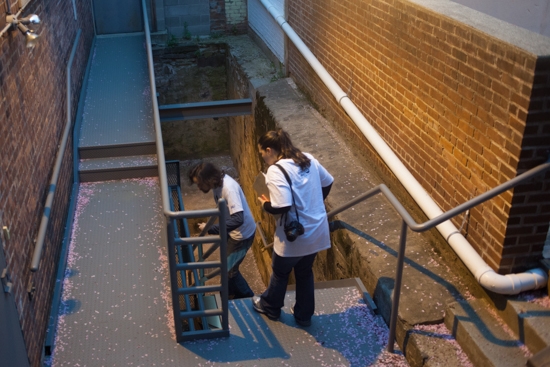
Thomas MacMillan Photo
In the pre-dawn hours, a dozen teams of white-shirted volunteers fanned out across the city, taking part in a sprawling game of hide-and-seek.
They looked in bushes, down alleys, under stairs and bridges, and in the woods, seeking out homeless people wherever they might be hiding.
The seekers were part of a massive, citywide effort to house about three-quarters of New Haven’s chronically homeless within 100 days. The volunteers were looking for homeless people to answer survey questions, to find out who among those sleeping in shelters or outdoors are the most vulnerable to harm.
The “100-day challenge” began last month when local and regional homelessness-services providers joined forces and laid out a plan of action. The group has set a July 30 deadline for the housing push, which has three main components. In order to house those who are the most vulnerable, the team has to assess the need that exists, assist the neediest to be housing-ready, and then assign them to now homes.
Tuesday’s efforts were part of the first step: assessment. During “registry week” for the 100-day challenge this week, the team is trying to figure out who are the homeless who most need housing. Organizers are hoping to assess 500 people this week.
On three mornings this week, providers and volunteers planned pre-dawn outreach efforts. At about 3:30 a.m. on Tuesday, about 60 people gathered at the Yale Program for Recovery and Community Health’s offices in Erector Square.

Jennifer Nulty (at right in photo), a Columbus House staffer and outreach team leader, explained the reason for starting at such an ungodly hour.
“At four in the morning, if you find somebody outside, they’re probably homeless,” she said. Also, homeless people with drug and alcohol addictions are most lucid early in the morning. “That’s the most coherent and sober they’re going to be.”
Nulty went over the assessment tool that volunteers are using, a survey known by the cumbersome acronym: VI-SPDAT. The surveys, filled out by providers based on a subject’s verbal answers to a list of questions, ask about homelessness history, access to health care and services, experiences of violence or exploitation, drug use, and debts.
Based on their answers, survey respondents are given a score of one to 20. A low score means the respondent is low-risk and could probably be placed in mainstream housing. A medium score means the person might need one-time assistance, rapid rehousing. A high score means he might need permanent supportive housing
Nulty said organizers are hoping to house everyone with a score above four. They’ll be targeting especially those people with high scores who also meet the definition of “chronically homeless”; disabled in some way, and homeless for more than a year or at least four times in three years.
At about 4:30 a.m., the group divided into teams of four or five and headed out, clipboards in hand.

Columbus House’s Veronica Cruz (at center in photo) headed up a team bound for downtown. She and four others piled into a green Mercury Mariner and drove to College Street, near the corner of Elm. They patrolled the blocks east of the Green, checking first behind the public library.
“That doesn’t look like where someone would sleep, right?” asked volunteer J.R. Logan as he passed a parking garage.
“You’d be surprised,” said Cruz. People sleep in all kinds of nooks, including the narrow spaces behind Dumpsters, she said.
At the corner of Orange and Elm, Logan peeked over a wall, looking into a corner behind a parking attendant booth.
“You’re getting it!” Cruz said.
Cruz said people sleeping downtown tend to get up before dawn, so that they don’t get discovered as the city wakes up. She said they often can’t begin sleeping until well past midnight, giving them only a few hours of rest.
The team headed south on Church Street, checked the Dunkin Donuts near Center Street and a couple of bus shelters near the corner of Crown Street. They found people who had either taken the assessment already, or who refused to participate.
As the morning wore on and the sky brightened, the team still found no one, even on the Green, where they had found so many people just the day before that they had run out of surveys.
“I’m really stumped right now,” Cruz said, baffled by the absence of homeless people.
Eventually she found one man, Jeffrey Gillespie, who said he was homeless and had been so for about 18 months. She ran through about half of the multi-page VI-SPDAT before Gillespie had to run to catch the bus.

By about 6:30 a.m., with another team nearby, there were more white-shirted volunteers on the Green than anybody else.
“I have never seen it this empty before,” Cruz said. Her team decided to pack it in, having completed one and half assessments for the morning.
Back at the Erector Square headquarters, other teams were rolling in and handing over their completed assessments. Columbus House’s Betsy Branch said her team had found a man camped under a bridge on State Street. Lisbette De La Cruz said her team found a small encampment in Fair Haven.
All together, Tuesday’s outreach effort resulted in 39 completed assessments.
People are also administering the VI-SPDAT this week at “in-reach” locations — homeless shelters, the public library, the emergency room, the VA.
All the data will be compiled and presented at a United Way on Wednesday at 9 a.m.
Then begins the next phase of the 100-day challenge — helping the most vulnerable homeless to get ready to move into homes of their own.